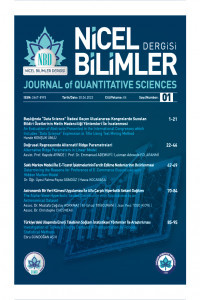Türkiye Pay Piyasası Etkinliğinin Çok Ölçekli Sample Entropi ile Analizi
Bu çalışma, Türkiye borsasında piyasa endeksi ve beş ana sektör endeksinin piyasa etkinliğini değerlendirmektedir. Çalışmada kullanılan endeksler sırasıyla BIST 100 (XU100), BIST Sinai (XUSIN), BIST Hizmetler (XUHIZ), BIST Ulastırma (XULAS), BIST Mali (XUMAL), BIST Teknoloji (XUTEK) olup, calışma dönemi 01/2017-07/2022 tarihleri arasını kapsamaktadır. Veri seti iki ayrı döneme ayrılmış olup, çalışmada COVID-19 pandemisi öncesi ve sonrası için piyasa etkinliği arastırılmıştır. Piyasa etkinliği, 1 ila 20 işlem günü arasındaki ölçekler için çok ölçekli entropi yaklasımlı bir yöntemle hesaplanmaktadır. Entropi, piyasa etkinliği problemini ya hep ya hiç biçiminde ele alan önceki yöntemlerin aksine, göreceli bir etkinlik derecesi sağlayabilmektedir. Günlük ölçekte piyasa etkinliği tahmin edildiğinde, COVID-19 pandemi öncesi dönemde en yüksek etkinliğe XUHIZ, XU100 ve XULAS endeksleri sahipken, COVID-19 pandemi sonrası dönemde XUMAL ve XU100 endeksleri en yüksek etkinliğe sahip olduğu tespit edilmiştir. Sonuclar, COVID-19 salgını nedeniyle tüm endekslerin etkinliğinin düştüğünü ve XULAS endeksinin bilgi etkinliginin en fazla düşüşe sahip oldugunu göstermektedir. Her iki periyotta da zaman ölçeği arttıkça bilgi etkinligi seviyelerine ilişkin genel bir azalma eğilimi bulgulanmıştır. Bu nedenle, endeksler belirli zaman ölçekleri için tam olarak etkin olmayıp kısmi etkinliğe sahiptir.
Anahtar Kelimeler:
Sample Entropi, Piyasa etkinliği, COVID-19, Borsa İstanbu
Multi-Scale Sample Entropy Analysis of the Turkish Stock Market Efficiency
This study evaluates the market efficiency of the market index and five main sector indices in the Turkish stock market: BIST 100 (XU100), BIST Industrials (XUSIN), BIST Services (XUHIZ), BIST Transportation (XULAS), BIST Financials (XUMAL), and BIST Technology (XUTEK) for the pre-and post-COVID-19 pandemic, covering the period from January 2017 to July 2022. Market efficiency is calculated using a multiscale entropy-based method for the scales of 1 to 20 business days. Entropy can yield a relative degree of efficiency, by contrast with previous methods that dealt with the efficiency question in all-or-nothing form. On a daily scale, during the pre-COVID-19 pandemic period, the XUHIZ, XU100 and XULAS indices exhibit the highest efficiency. However, in the post-COVID-19 pandemic period, the XUMAL and XU100 indices demonstrate the highest efficiency. The findings suggest that the efficiency of all indices has declined due to the COVID-19 pandemic, with the XULAS index showing the most significant decrease in informational efficiency. A general tendency of reduced informational efficiency levels is found as the time scale increases in both periods. Therefore, the indices are partially efficient for certain time scales, indicating that they are not fully efficient.
Keywords:
Sample Entropy, Market efficiency, COVID-19, Borsa İstanbul,
___
- Alijani, M., Banimahd, B., Nikoomaram, H. and Yaghobnezhad, A. (2021), Fractal analysis and the relationship between efficiency of capital market indices and COVID-19 in Iran, Results in Physics, 25, 104262.
- Altuntas, M., Kilic, E., Pazarci, Ş. ve Umut, A. (2022), Borsa İstanbul Alt Endekslerinde Etkin Piyasa Hipotezinin Test Edilmesi: Fourier Kırılmalı ve Doğrusal Olmayan Birim Kök Testlerinden Kanıtlar, Ekonomi, Politika & Finans Araştırmaları Dergisi, 7(1), 169–185.
- Alvarez-Ramirez, J., Rodriguez, E. and Alvarez, J. (2012), A multiscale entropy approach for market efficiency, International Review of Financial Analysis, 21, 64–69.
- Choi, S. Y. (2021), Analysis of stock market efficiency during crisis periods in the US stock market: Differences between the global financial crisis and COVID-19 pandemic, Physica A: Statistical Mechanics and Its Applications, 574.
- Eyuboglu, K. ve Eyuboglu, S. (2020), Borsa İstanbul sektör endekslerinin etkinliğinin fourier birim kök testleri İle Analizi, Uluslararası İktisadi ve İdari İncelemeler Dergisi, 29, 23–44.
- Gulko, L. (1999), The entropic market hypothesis, International Journal of Theoretical and Applied Finance, 2(3), 293–329.
- Ildirar, M. and Dalli, T. (2021), Etkin piyasa hipotezinin türk bankacilik sektörü üzerine uygulaması, Journal of Economics and Research.
- Karademir, F. ve Evci, S. (2020). Borsa İstanbul’da zayif formda piyasa etkinliğinin test edilmesi: sektörel çerçevede bir analiz. Business & Management Studies: An International Journal, 8(1), 82–100.
- Mandelbrot, B. B. (1971). When can price be arbitraged efficiently? A limit to the validity of the random walk and martingale models. The Review of Economics and Statistics, 53(3), 225.
- Oh, G., Kim, S., and Eom, C. (2007). Market efficiency in foreign exchange markets. Physica A: Statistical Mechanics and Its Applications, 382(1), 209–212.
- Oh, G., Kim, S., and Eom, C. (2007). Market efficiency in foreign exchange markets. Physica A: Statistical Mechanics and Its Applications, 382(1), 209–212.
- Ortiz-Cruz, A., Rodriguez, E., Ibarra-Valdez, C. and Alvarez-Ramirez, J. (2012), Efficiency of crude oil markets: Evidences from informational entropy analysis, Energy Policy, 41, 365–373.
- Richman, J. S. and Moorman, J. R. (2000), Physiological time-series analysis using approximate entropy and sample entropy, American Journal of Physiology-Heart and Circulatory Physiology.
- Wang, G.-J., Xie, C. and Han, F. (2012), Multi-Scale Approximate Entropy Analysis of Foreign Exchange Markets Efficiency, Systems Engineering Procedia, 3, 201–208.
- Wang, J. and Wang, X. (2021), COVID-19 and financial market efficiency: Evidence from an entropy-based analysis. Finance Research Letters, 42, 101888.
- Yucel, Ö. (2016) Finansal Piyasa Etkinliği: Borsa İstanbul Üzerine Bir Uygulama, International Review of Economics and Management, 4(3), 107–123.
- ISSN: 2667-8993
- Yayın Aralığı: Yılda 2 Sayı
- Başlangıç: 2019
- Yayıncı: Eskişehir Osmangazi Üniversitesi
Sayıdaki Diğer Makaleler
İsa GÜL, Özlem GEDİK, Mustafa CANBAZ, Sinan SARAÇLI
Türkiye Pay Piyasası Etkinliğinin Çok Ölçekli Sample Entropi ile Analizi
Beste Buse YILDIRIM, Mehmet YILMAZ
Combating Multicollinearity: A New Two-Parameter Approach
Janet Iyabo IDOWU, Olasunkanmi James OLADAPO, Abiola Timothy OWOLABİ, Kayode AYİNDE, Oyinlade AKİNMOJU
Avrupa Birliği'nde Ekonomik Güvenlik ve Fiziksel Güvenlik: Çok Değişkenli Bir İstatistiksel Analiz
